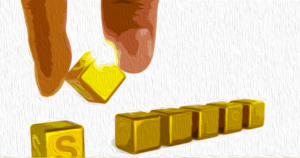
Bitcoin's Impressive Year-to-Date Performance
Bitcoin (BTC), the leading digital currency by market cap, has experienced a remarkable surge of over 100% this year. This significant growth has piqued the interest of many, raising questions about how long this upward trajectory will continue. Gareth Soloway, the head market strategist at inthemoneystocks.com, recently discussed the potential longevity of this rally, shedding light on what lies ahead for Bitcoin.
Federal Reserve and 10-Year Treasury Yields
During a recent interview, Soloway touched upon two key factors that could impact Bitcoin's future. Firstly, he highlighted the upcoming gathering of the U.S. Federal Reserve and its potential influence on the market. Secondly, he drew attention to the surge in 10-year treasury yields, which have reached levels not seen in the past 16 years.
Market's Current Focal Point
Soloway emphasized the significance of the Federal Reserve's decision regarding the federal funds rate. He noted that the recent surge in 10-year treasury yields, surpassing 5%, holds great psychological importance for the market. In line with Bill Gross' prediction, Soloway expressed concerns about a possible recession in the fourth quarter of this year, highlighting the contrasting levels of consumer confidence across different income brackets.
Bitcoin's Resilience Amidst Market Turmoil
While discussing Bitcoin, Soloway speculated on the potential approval of a spot Bitcoin exchange-traded fund (ETF). He cautioned that such approval could trigger a significant sell-off, raising doubts about Bitcoin's ability to withstand a potential 15-20% asset sell-off in the Nasdaq. Soloway expressed concern that a 35% plunge in the stock market could eventually create fear and panic among Bitcoin holders.
The Future of Bitcoin Post-ETF Approval
Looking ahead, Soloway contemplated the narratives that could propel Bitcoin's price after the approval of an ETF. He noted the growing acceptance of Bitcoin as a legitimate asset class by institutional investors, drawing parallels with gold. In times of market turbulence, Soloway predicted an increase in demand for Bitcoin and suggested that the next resistance level during this upward trend could be around $47,000 per unit.
Potential Price Volatility and Gold Forecast
Despite the positive outlook, Soloway acknowledged the possibility of Bitcoin falling to the $15,000 range if the stock markets experience a sharp decline and widespread panic ensues. He emphasized that panic is a powerful emotion and could still impact Bitcoin's price. Additionally, Soloway expressed optimism about the future of gold, predicting a potential surge to $2,400 to $2,500 by the end of 2024.
In conclusion, Gareth Soloway's insights provide valuable perspective on the longevity of Bitcoin's rally and its resilience amidst market turmoil. While there are potential risks and uncertainties, the future of Bitcoin and its potential as a digital asset continue to captivate the attention of investors and enthusiasts alike. What are your thoughts on Soloway's predictions? Share your opinions in the comments section below.
Frequently Asked Questions
Is it possible to hold a gold ETF within a Roth IRA
You may not have this option with a 401(k), however, you might want to consider other options, like an Individual retirement account (IRA).
Traditional IRAs allow contributions from both the employer and employee. You can also invest in publicly traded businesses by creating an Employee Stock Ownership Plan (ESOP).
An ESOP is a tax-saving tool because employees have a share of company stock as well as the profits that the business generates. The tax rate on money that is invested in an ESOP is lower than if it was held in the employees' hands.
A Individual Retirement Annuity (IRA), is also available. You can make regular payments to your IRA throughout your life, and you will also receive income when you retire. Contributions to IRAs can be made without tax.
What are the pros & cons of a Gold IRA?
An Individual Retirement Plan (IRA) has a major advantage over regular savings accounts. It doesn't tax any interest earned. This makes an IRA a great choice for people who are looking to save money but don’t want to pay any tax on the interest earned. But, this type of investment comes with its own set of disadvantages.
You may lose all your accumulated savings if you take too much out of your IRA. The IRS may prevent you from taking out your IRA funds until you reach 59 1/2. If you do withdraw funds, you'll need to pay a penalty.
You will also need to pay fees for managing your IRA. Many banks charge between 0.5%-2.0% per year. Others charge management fees that range from $10 to $50 per month.
If you prefer to keep your money outside a bank, you'll need to purchase insurance. A majority of insurance companies require that you possess a minimum amount gold to be eligible for a claim. It is possible that you will be required to purchase insurance that covers losses of up to $500,000.
If you decide to open a gold IRA, it is important to know how much you can use. Some providers limit the amount of gold that you are allowed to own. Others allow you to pick your weight.
Also, you will need to decide if you want to buy physical gold futures contracts or physical gold. Gold futures contracts are more expensive than physical gold. However, futures contracts give you flexibility when buying gold. They allow you to set up a contract with a specific expiration date.
Also, you will need to decide on the type of insurance coverage you would like. The standard policy does NOT include theft protection and loss due to fire or flood. It does offer coverage for natural disasters. If you live in a high-risk area, you may want to add additional coverage.
Additional to your insurance, you will need to consider how much it costs to store your gold. Storage costs are not covered by insurance. For safekeeping, banks typically charge $25-40 per month.
To open a IRA in gold, you will need to first speak with a qualified custodian. Custodians keep track of your investments and ensure compliance with federal regulations. Custodians don't have the right to sell assets. Instead, they must hold them as long as you request.
Once you've chosen the best type of IRA for you, you need to fill in paperwork describing your goals. The plan should contain information about the types of investments you wish to make such as stocks, bonds or mutual funds. Also, you should specify how much each month you plan to invest.
After filling out the forms, you'll need to send them to your chosen provider along with a check for a small deposit. After reviewing your application, the company will send you a confirmation mail.
A financial planner is a good idea when opening a gold IRA. Financial planners are experts in investing and will help you decide which type of IRA works best for your situation. They can help you find cheaper insurance options to lower your costs.
What are the advantages of a gold IRA
An Individual Retirement Account (IRA) is the best way to put money towards retirement. It's not subject to tax until you withdraw it. You have complete control over how much you take out each year. There are many types to choose from when it comes to IRAs. Some are better suited for college students. Others are intended for investors seeking higher returns. Roth IRAs let individuals contribute after age 591/2 and pay tax on any earnings at retirement. However, once they begin withdrawing funds, these earnings are not taxed again. This type of account might be a good choice if your goal is to retire early.
A gold IRA is similar to other IRAs because it allows you to invest money in various asset classes. Unlike a regular IRA where you pay taxes on gains, a gold IRA doesn't require you to worry about taxation while you wait to get them. This makes gold IRA accounts excellent options for people who prefer to keep their money invested instead of spending it.
An additional benefit to owning gold through an IRA, is the ease of automatic withdrawals. You won't have the hassle of making deposits each month. To ensure that you never miss a payment, you could set up direct debits.
Finally, gold remains one of the best investment options today. It is not tied to any country so its value tends stay steady. Even in economic turmoil, gold prices tends to remain relatively stable. Gold is a good option for protecting your savings from inflation.
Statistics
- You can only purchase gold bars at least 99.5% purity. (forbes.com)
- Instead, the economy improved, stocks rebounded, and gold plunged, losing 28 percent of its value in 2013. (aarp.org)
- Gold is considered a collectible, and profits from a sale are taxed at a maximum rate of 28 percent. (aarp.org)
- Indeed, several financial advisers interviewed for this article suggest you invest 5 to 15 percent of your portfolio in gold, just in case. (aarp.org)
- (Basically, if your GDP grows by 2%, you need miners to dig 2% more gold out of the ground every year to keep prices steady.) (smartasset.com)
External Links
wsj.com
- Saddam Hussein's InvasionHelped Uncage a Bear in 1990 – WSJ
- How do you keep your IRA Gold at Home? It's Not Exactly Legal – WSJ
finance.yahoo.com
bbb.org
cftc.gov
How To
The History of Gold as an Asset
From the ancient days to the early 20th Century, gold was a common currency. It was universally accepted and loved for its beauty, durability, purity and divisibility. Due to its value, it was also internationally traded. There were different measures and weights for gold, as there was no standard to measure it. For example in England, a pound sterling equals 24 carats. In France, a livre tournois equals 25. Carats of golden. Germany had one mark which equals 28. Carats.
The United States started issuing American coins in the 1860s made of 90% copper and 10% zinc. This caused a drop in foreign currency demand which resulted in an increase of their prices. The United States began minting large quantities gold coins at this time, which led to a drop in the price. The U.S. government needed to find a solution to their debt because there was too much money in circulation. To do so, they decided to sell some of the excess gold back to Europe.
Since most European countries were not confident in the U.S. dollar they began accepting gold as payment. However, many European nations stopped using gold to pay after World War I and started using paper currency instead. Since then, the price of gold has increased significantly. Even though the price of gold fluctuates, it remains one the best investments you can make.
—————————————————————————————————————————————————————————————–
By: Jamie Redman
Title: The Longevity of Bitcoin Examined: Insights from Market Strategist Gareth Soloway
Sourced From: news.bitcoin.com/market-expert-gareth-soloway-explores-bitcoins-future-amidst-rising-treasury-yields-and-etf-speculation/
Published Date: Fri, 27 Oct 2023 18:00:55 +0000
Did you miss our previous article…
https://altcoinirareview.com/ethereums-dencun-upgrade-faces-delay-amid-testing-requirements/















